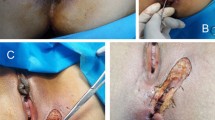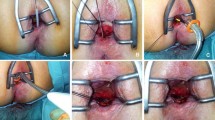Abstract
Background
Surgical management of anal fistulas in Crohn’s disease (CD) is associated with high failure rates, and treatment options are limited due to ongoing proctitis, multiple tracts, and concern for incontinence and non-healing wounds. The aim of this study was to investigate the healing rate of ligation of the inters-sphincteric fistula tract (LIFT) for anal fistulas in Crohn’s disease and identify prognostic factors for healing.
Methods
This prospective analysis compared long-term healing rates of CD patients undergoing LIFT for anal fistulas. Consecutive patients with CD who underwent LIFT procedure at our institution, in the period from March 2012 to September 2019 were included. The main outcome was anal fistula healing rate.
Results
The study cohort of 46 patients (mean age of 34.2 ± 13.0 years, 18 (40%) males). After a mean follow-up time of 33 ± 28 months, fistula healing was seen in 30 (65%) patients. A total of 8 patients were noted to have inter-sphincteric recurrence and 8 patients had trans-sphincteric recurrence. Smoking at the time of surgery was significantly associated with LIFT failure (HR 3.18, 95% CI 1.18–8.61, p = 0.02). Other factors, such as age, sex, race, disease duration and location, type of fistula history of proctitis, preoperatively use of biologics or a seton, and previous repair attempts, did not appear to influence LIFT healing. Although not statistically significant, there was a trend toward increase in failure among patients with active proctitis at the time of surgery (HR 1.97, 95% CI 0.71–5.42, p = 0.19).
Conclusion
Our increasing experience with LIFT for anal fistula in CD demonstrates a higher rate of healing (65%) than previously reported (48%). Smoking appears to negatively influence healing of LIFT in CD.


Similar content being viewed by others
Availability of data and material
All data and materials support the published claims and comply with field standards.
Code availability
Not applicable.
References
Schwartz DA, Loftus EV Jr, Tremaine WJ et al (2002) The natural history of fistulizing Crohn’s disease in Olmsted County. Minn Gastroenterol 122:875–880
Schwartz DA, Herdman CR (2004) Review article: the medical treatment of Crohn’s perianal fistulas. Aliment Pharmacol Ther 19:953–967
Williamson PR, Hellinger MD, Larach SW et al (1995) Twenty-year review of the surgical management of perianal Crohn’s disease. Dis Colon Rectum 38:389–392
Present DH, Rutgeerts P, Targan S et al (1999) Infliximab for the treatment of fistulas in patients with Crohn’s disease. N Engl J Med 340(18):1398–1405
Bouguen G, Siproudhis L, Gizard E et al (2013) Long-term outcome of perianal fistulizing Crohn’s disease treated with infliximab. Clin Gastroenterol Hepatol 11(8):975-81.e1–4
Grimaud JC, Munoz-Bongrand N, Siproudhis L et al (2010) Fibrin glue is effective healing perianal fistulas in patients with Crohn’s disease. Gastroenterology 138:2275–2281
O’Riordan JM, Datta I, Johnston C et al (2012) A systematic review of the anal fistula plug for patients with Crohn’s and non-Crohn’s related fistula-in-ano. Dis Colon Rectum 55:351–358
Rojanasakul A, Pattanaarun J, Sahakitrungruang C et al (2007) Total anal sphincter saving technique for fistula-in-ano; the ligation of intersphincteric fistula tract. J Med Assoc Thai 90:581–586
Aboulian A, Kaji AH, Kumar RR (2011) Early result of ligation of the intersphincteric fistula tract for fistula-in-ano. Dis Colon Rectum 54:289–292
Bleier JI, Moloo H, Goldberg SM (2010) Ligation of the intersphincteric fistula tract: an effective new technique for complex fistulas. Dis Colon Rectum 53:43–46
Shanwani A, Nor AM, Amri N (2010) Ligation of the intersphincteric fistula tract (LIFT): a sphincter-saving technique for fistula-in-ano. Dis Colon Rectum 53:39–42
Sileri P, Franceschilli L, Angelucci GP et al (2011) Ligation of the intersphincteric fistula tract (LIFT) to treat anal fistula: early results from a prospective observational study. Tech Coloproctol 15:413–416
Tan K, Tan IJ, Lim FS et al (2011) The anatomy of failures following the ligation of intersphincteric tract technique for anal fistula: a review of 93 patients over 4 years. Dis Colon Rectum 54:1368–1372
Mushaya C, Bartlett L, Schulze B et al (2012) Ligation of intersphincteric fistula tract compared with advancement flap for complex anorectal fistulas requiring initial seton drainage. Am J Surg 204:283–289
Gingold CS, Murrell ZA, Fleshner PR (2014) A prospective evaluation of the ligation of the intersphincteric tract procedure for complex anal fistula in patients with Crohn’s disease. Ann Surg 260:1057–1061
Kaminski JP, Zaghiyan K, Fleshner PR (2017) Increasing experience of ligation of the intersphincteric fistula tract for patients with Crohn’s disease: what have we learned? Colorectal Dis 19:750–755
van Pragg EM, Stellingwerf ME, van der Bilt JD et al (2020) Ligation of the intersphincteric fistula tract and endorectal advancement flap for high perianal fistulas in Crohn’s disease: a retrospective cohort study. J Crohns Colitis 14(6):757–763
Parks AG, Gordon PH, Hardcastle JD (1976) A classification of fistula-in-ano. Br J Surg 63:1–12
Mizrahi N, Wexner SD, Zmora O et al (2002) Endorectal advancement flap: are there predictors of failure? Dis Colon Rectum 45(12):1616–1621
Makowiec F, Jehle EC, Becker HD, Starlinger M (1995) Clinical course after transanal advancement flap repair of perianal fistula in patients with Crohn’s disease. Br J Surg 82(5):603–606
Joo JS, Weiss EG, Nogueras JJ, Wexner SD (1998) Endorectal advancement flap in perianal Crohn’s disease. Am Surg 64(2):147–150
Mujukian A, Truong A, Fleshner P, Zaghiyan K (2020) Long-term healing after complex anal fstula repair in patients with Crohn’s disease. Tech Coloproctol 24:833–841
Smith BR, Arnott ID, Drummond HE et al (2004) Disease location, anti-Saccharomyces cerevisiae antibody, and NOD2/CARD15 genotype influence the progression of disease behavior in Crohn’s disease. Inflamm Bowel Dis 10:521–528
Aldhous MC, Drummond HE, Anderson N et al (2007) Does cigarette smoking influence the phenotype of Crohn’s disease? Analysis using the Montreal classification. Am J Gastroenterol 102:577–588
Zimmerman DD, Delemarre JB, Gosselink MP et al (2003) Smoking affects the outcome of transanal mucosal advancement flap repair of trans-sphincteric fistulas. Br J Surg 90:351–354
El-Gazzaz G, Hull T, Mignanelli E et al (2010) Analysis of function and predictors of failure in women undergoing repair of Crohn’s related rectovaginal fistula. J Gastrointest Surg 14:824–829
Atia O, Asayag N, Focht G, et al (2021) Perianal Crohn’s disease is associated with poor disease outcome: a nation-wide study from the epiIIRN cohort. Clin Gastroenterol Hepatol. https://doi.org/10.1093/ecco-jcc/jjab204
Funding
Not applicable.
Author information
Authors and Affiliations
Contributions
All authors contributed to the study conception and design. Material preparation, data collection and analysis were performed by all authors. The first draft of the manuscript was written by TW and all authors commented on previous versions of the manuscript. All authors read and approved the final manuscript.
Corresponding author
Ethics declarations
Conflict of interest
The authors declare that they have no conflict of interest.
Ethics approval
All research-related activities were approved by the Cedars-Sinai Medical Center Institutional Review Board (IRB # 29837).
Consent to participate
Informed consent was obtained from all individual participants included in the study.
Consent for publication
Patients signed informed consent regarding publishing their data.
Additional information
Publisher's Note
Springer Nature remains neutral with regard to jurisdictional claims in published maps and institutional affiliations.
Rights and permissions
About this article
Cite this article
Wood, T., Truong, A., Mujukian, A. et al. Increasing experience with the LIFT procedure in Crohn’s disease patients with complex anal fistula. Tech Coloproctol 26, 205–212 (2022). https://doi.org/10.1007/s10151-022-02582-4
Received:
Accepted:
Published:
Issue Date:
DOI: https://doi.org/10.1007/s10151-022-02582-4




